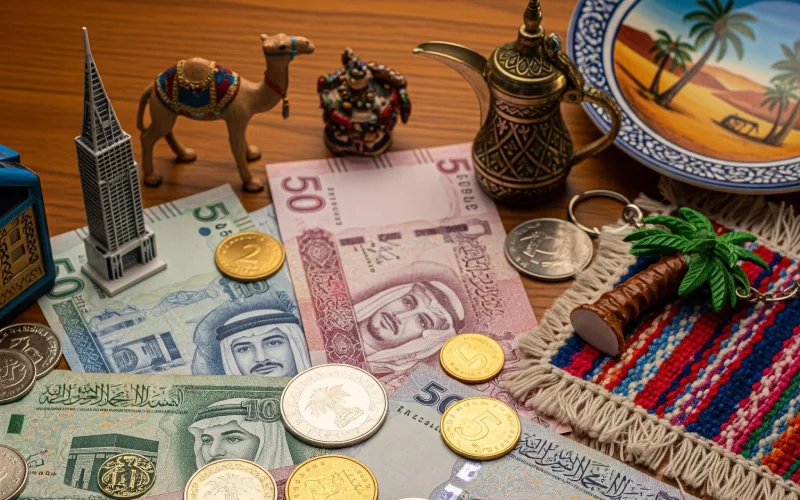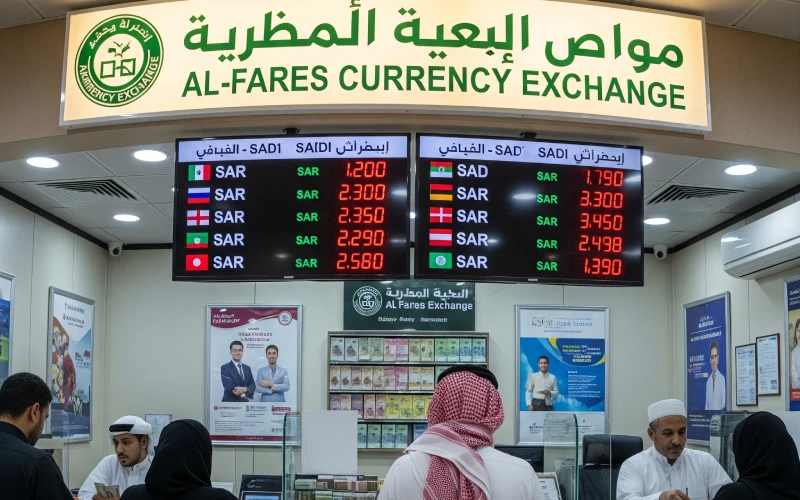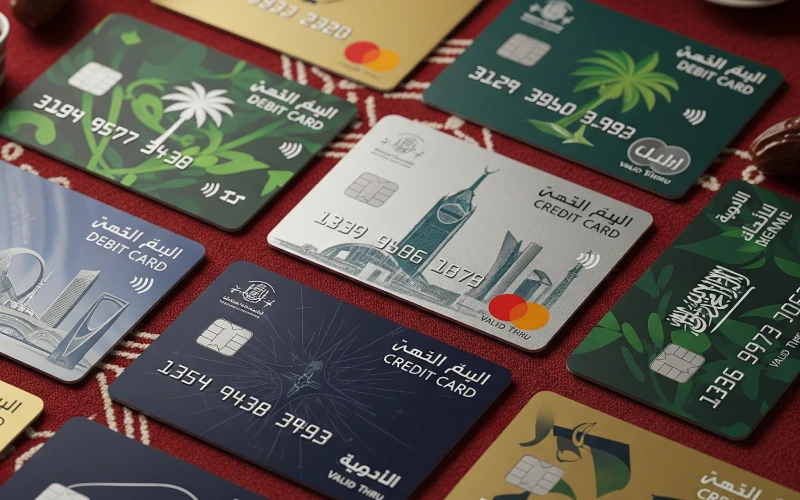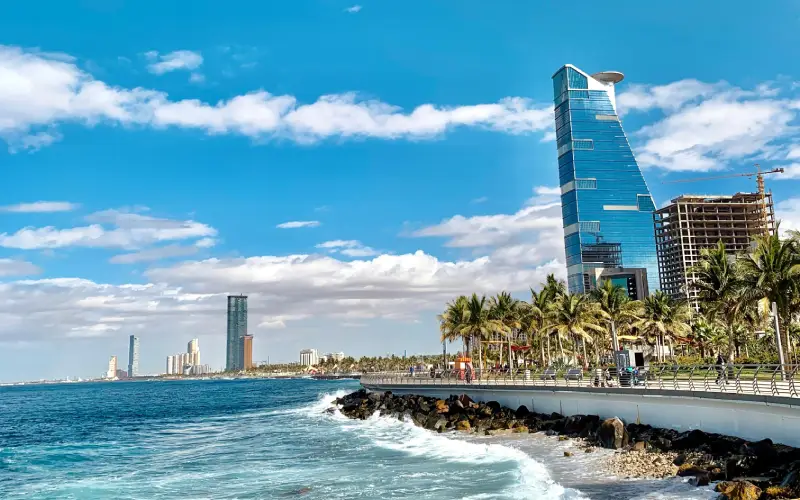While planning a trip to Saudi Arabia, you would have discussed everything, from hotels and restaurants to attractions, but do you realize that you have missed out on the core of all activities, money? How are you going to pay for food, activities, etc? What is the official Saudi Arabia currency, and how much is the exchange rate? Whether you’re arriving for leisure or going for business work, being financially prepared will help you enjoy your trip with fewer hassles. This guide covers details on exchange tips, card payments, budgeting, and more.
Overview of Saudi Currency
Before spending a single Saudi currency, it’s helpful to understand the basics of Saudi Arabia’s currency. Here is what the currency is, how it works, and what denominations run.

❖ What is the Currency Used in Saudi Arabia?
The official currency of Saudi Arabia is the Saudi Riyal, abbreviated as SAR. The currency symbol is ﷼. It is the only legal currency accepted throughout the country. In a nutshell, whether you are in Jeddah’s ancient Al-Balad or the cosmopolitan Riyadh, you’ll need to pay in Riyals.
❖ Understanding the Saudi Riyal (SAR)
The Saudi Central Bank is responsible for its issuance and regulation. Since 1986, the Riyal has been maintained at a fixed US dollar of 3.75 SAR, which provides secureness to the Saudi economy, which generates most of its funding from oil exports. This peg helps in keeping up the purchasing power of the Riyal and holds up financial market development within the Kingdom.
Each Riyal is divided into 100 halalas, although halalas are rarely used in practice.
Here are the approximate values of in Saudi Riyal in major currencies:
- 1 USD = 3.75 SAR (fixed rate)
- 1 AED (UAE Dirham) = 1.02 SAR
- 1 EUR (Euro) = 4.08 SAR
- 1 GBP (British Pound) = 4.79 SAR
- 1 INR (Indian Rupee) = 0.043 SAR
❖ Currency Denominations – Notes and Coins
Saudi paper money is available in 1, 5, 10, 50, 100, and 500 Riyals. These notes feature images of the Saudi kings and famous landmarks. Coins, which are less common, come in denominations of 1, 5, 10, 25, 50 halalas, and 1 and 2 Riyals. For your understanding, the most common day-to-day transactions that you will be involved in are banknotes, especially in cities.
Currency Exchange Tips for Tourists
Managing foreign currency can be knotty if you don’t know where to go or what to avoid. Here’s how to exchange money aptly and hook the most value during your stay in Saudi Arabia.
⊛ Best Places to Exchange Currency in Saudi Arabia
You’ll find money exchange services at airports, shopping malls, and in mid business areas. Some of the best options include major banks such as Al Rajhi, SNB, Alinma Bank and Riyad Bank, along with licensed exchange centers like Al-Amoudi Exchange, Al Natheer and Bin Yaala Exchange Co. These places offer fair rates and are safe to drop by. Also, these authorized places have a wider range of foreign currencies with a faster sevice.

⊛ Should You Exchange Before or After Arrival?
It’s a smart outlook on currency exchange to carry some Riyals with you when you arrive—enough to cover your first taxi ride, a happy meal, or a SIM card. But for larger exchanges, wait until you reach Saudi Arabia, where rates are generally better than in Dubai or your home country.
⊛ Tips for Getting the Best Exchange Rates
Here are 5 handy points for travelers, summarized in two lines each:
- Inform Your Bank: It’s better to keep your bank in loop of your travel dates and destinations to prevent your cards from being blocked. They can also help you know about foreign transaction fees and ATM withdrawal limits before you leave.
- Learn Basic Arabic Phrases: A few essential words in the local language, like “hello,” “please,” and “thank you” show respect and can ease your interactions to connect with locals.
- Be Watchful of Currency Exchange: Avoid exchanging large sums at airports or hotels as they charge heavy rates. Use ATMs with a plan rather than abruptly, or visit reputable banks and exchange offices in the city for better value.
- Never Forget Safety: Always be conscious of your surroundings, particularly in crowded areas, and keep valuables locked.
Using Debit & Credit Cards in Saudi Arabia
While cash is still used in some places, Saudi Arabia is mostly recognised for being cashless in metropolitan parts. Here is how to use cards, ATMs, and mobile payments with ease.
Popular Card Types Accepted
Saudi Arabia is absolutely, without doubt, card-friendly. Most restaurants, retail shops, hotels, and even small grocery stores accept Visa, Mastercard, and American Express. This helps avoid the stress of carrying large amounts of cash for most city travelers.

Availability & Fees of ATMs in Saudi Arabia
Traveling to Saudi Arabia is incredible and what makes the experience easy is the presence of ATMs at short distances. They are available in airports, malls, gas stations, and city streets. International cards work fine, although some machines may charge a fee. It’s best to tell your bank before traveling to avoid card blocks.
Mobile Payments and Contactless Transactions
You might have understood by now that contactless payments are the norm in Saudi Arabia. Many locals and tourists use mada Pay, Apple Pay, and STC Pay. If you’re using an international card, Apple Pay or Google Pay can be linked easily. Just make sure your bank supports international use.
Budgeting Your Trip
Since you have learnt so much about the currency, here is an extra dose of wisdom on budgeting in Saudi Arabia that will help you avoid overspending. From daily expenses to helpful apps, here’s how to stay on budget while traveling.
Daily Expenses for Tourists
With all the stats, the average spend for a traveler is around SAR 300 to 500 per day. Now his also depends on lifestyle. Budget travelers can enjoy in less, especially if they use public transport and dine at street eateries. Luxury travelers, on the other hand, should plan for upwards of SAR 1000 per day for fine dining and high-end hotels.
Cost of Common Items and Services
Here’s a general overview at what things might cost for a mid-budget trip:
- Cappuccino: SAR 12
- Bottle of water (500ml): SAR 2
- Metro ticket (Riyadh): SAR 4
- Mid-range restaurant meal: SAR 40–70
- Uber ride (say 5 km): SAR 20
- Entry to a museum: SAR 20–60
Currency Conversion Apps & Tools
Keep a check on how much you are spending, what activities are hitting the red line, and how much money you need to exchange for the trip. Then, use apps like XE Currency, Google Currency Converter, or OANDA to get the exact exchange rates, which are easy to use on the go.
Things to Avoid with Currency in Saudi Arabia
Currency mistakes can be terrible, both financially and legally. Here’s what to steer clear of when handling money in Saudi Arabia.
Black Market Currency Exchange Risks
Avoid exchanging money with unofficial dealers. How do you know they are a fraud? They may offer lucrative, cheap deals. It may be appealing if someone offers a better rate, but it’s illegal and risky. Fake notes, scams, or legal risks are not worth the small savings.
Tips to Avoid Scams or Hidden Charges
- Always ask for a receipt when exchanging money.
- Avoid dynamic currency conversion at card terminals. Choose SAR instead of your home currency.
- Confirm and verify properly the ATM and card fees with your bank.
- Count your cash before leaving the counter and store it securely.
Final Currency Tips for Travelers
How Much Cash Should You Carry?
Carry a small amount of cash, around SAR 500–700, for tips, local transport, or purchases in areas with tight card access. In cities, digital and card payments cover most needs.
Keeping Your Money Safe While Traveling
Use a money belt or hidden pouch to store extra cash. Leave unnecessary cards at your hotel and keep only what you need for the day in your wallet. Also, don’t rely entirely on one method of payment—bring both card and cash options.
FAQs About Saudi Arabia Currency
1) Can I use dollars or UAE dirhams in Saudi Arabia?
2) Are currency exchange counters available at the airport?
3) Can I use my Dubai-based credit card in Saudi Arabia?
4) Are cards accepted in remote areas?
5) Is it safe to withdraw money from ATMs at night?
Conclusion
Understanding how to handle the Saudi Arabia currency will make your trip smoother and more secure. From knowing where to exchange Riyals to choosing the right payment methods and avoiding scams, a little planning goes a long way. Whether you’re shopping in Riyadh or sipping qahwa in a local café, smart money habits will help you focus on enjoying every moment of your journey.

Travel influencer, explorer, and storyteller dedicated to discovering the world’s hidden treasures. For me, travel is more than passion – it’s a lifestyle.



